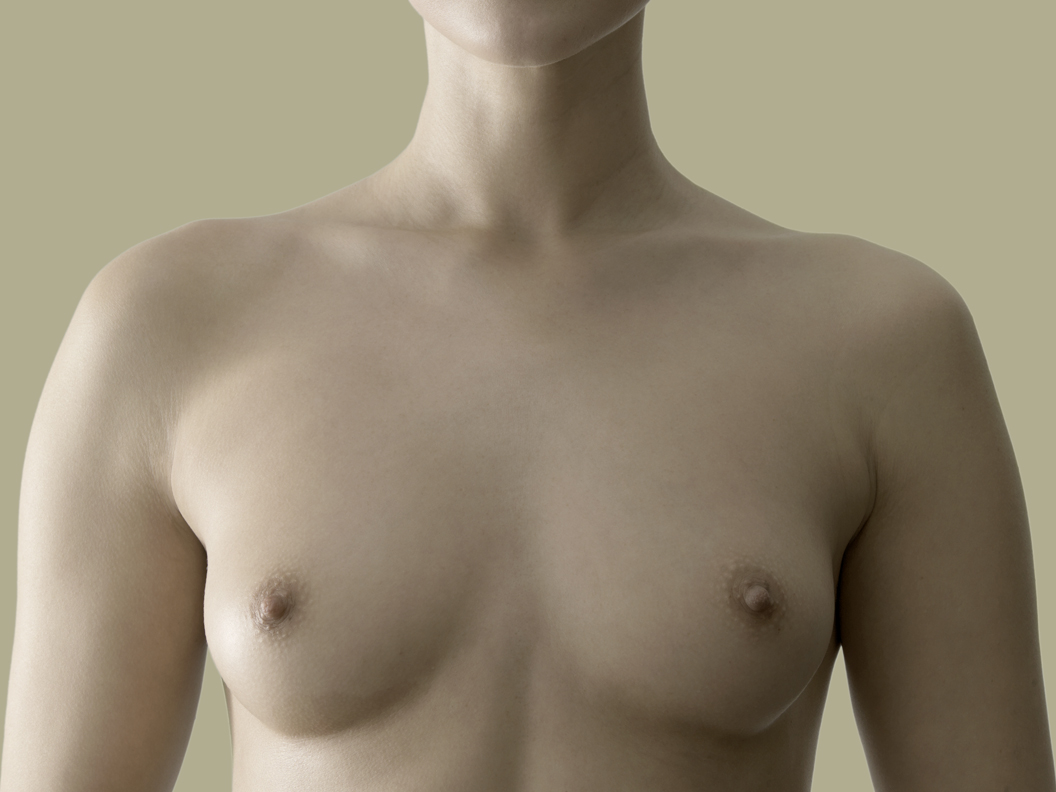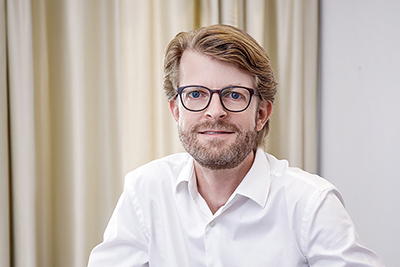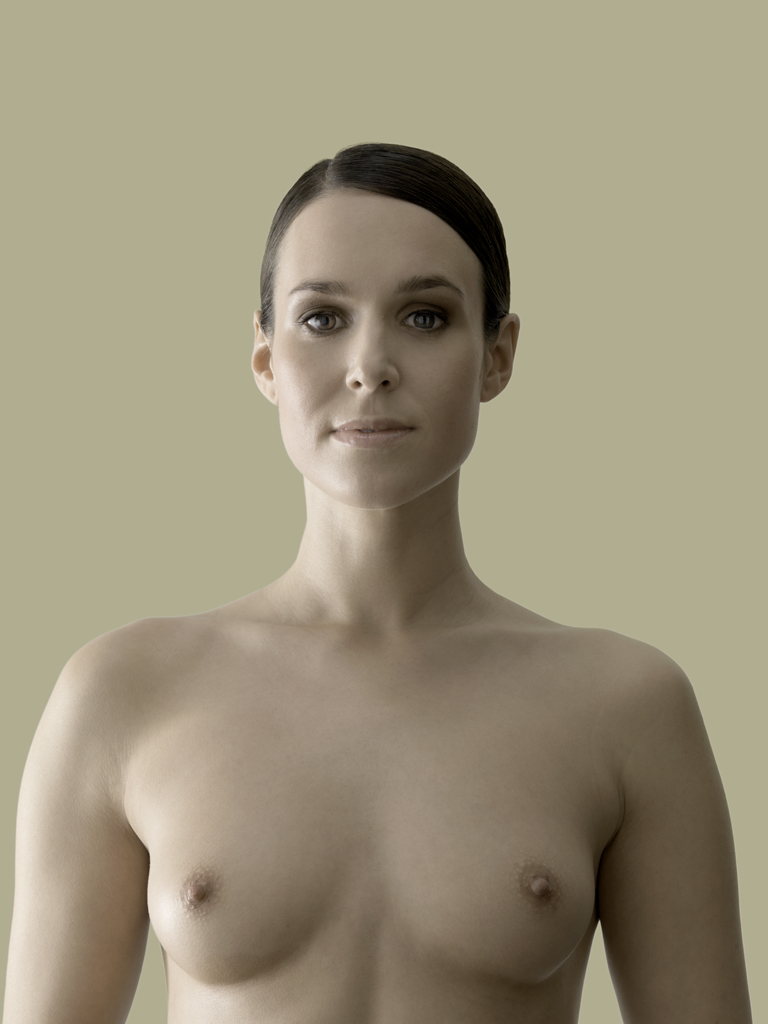
Considerations
When to consider breast implants:- You feel your breasts are too small (hypoplasia)
- You feel uncomfortable in swimwear or tight-fitting tops because of your breast size.
- Your breasts have lost their former volume and firmness after pregnancy and/or breastfeeding (involution atrophy).
- Your breasts have become smaller and lost their elasticity over time.
- Your breasts are too small or sag down due to weight loss.
- One breast is noticeably smaller than the other (asymmetry)
- One, or both breasts are abnormally shaped and too small.
- Your breasts have developed asymmetrically (mammary asymmetry).
- Certain breast deformities can be corrected with implants.
- If your breasts have completely lost their elasticity (Mastoptosy), breast augmentation along with a breast lift can be considered.
Consultation
A prerequisite to a successful operation is careful planning. This starts with a personal consultation at the AARE KLINIK.- Communication of wishes and expectations ascertain what you would like to improve.
- Explanation of the possibilities and scope of the operation.
- Medical history is taken.
- Physical examination is performed.
- Digital photos are taken.
- Desired breast size and shape are discussed, as well as the position and size of the nipples.
- Pre-existing asymmetry in the breasts or chest, skin quality and existing scars are ascertained.
- Individual factors and personal wishes help in jointly deciding the right breast size and choice of appropriate surgical technique, the position of incisions and resulting scars.
- Based on this, an individual treatment plan is drawn up and goals of the operation are discussed and defined.
- Risks and possible complications are discussed and documented.
- Full medical history (pre-existing conditions and previous surgery).
- Current diseases (high blood pressure, diabetes, thyroid dysfunction).
- Allergies or aversion to medications.
- Any important medical reports.
- Please bring any important medical information (in particular anything relating to your breasts, e.g. mammography) along to the consultation and inform the surgeon if you have a history of breast cancer in your family.
- If you are planning to loose a significant amount of weight or to get pregnant, this should be considered when planning a breast augmentation as the size of your breasts can alter unpredictably through weight fluctuation, pregnancy or breastfeeding.
- It may be advisable to wait for the stabilisation of your weight or until after pregnancy/breast feeding before surgery is undertaken.
- Depending on your age, personal and familial risk factors, it may be advisable to have an ultrasound examination or breast sonography before having a breast augmentation.
Procedure
The surgical procedure of a breast augmentation with implants depends primarily on three factors: 1. the breast implant 2. the access way of the implant 3. the implant position 1. Breast implants: Currently, saline or silicone gel filled breast implants are available. In both cases, the implant shell is made of silicone and can either be smooth-walled or roughened (textured). Textured implants are generally less prone to encapsulation by fibrous tissue (capsular fibrosis) than smooth implants. Breast implants can have a round or teardrop (anatomical) shape and are available in a variety of sizes and shapes. In saline implants, it is possible to insert the empty implant sleeve first through a very small incision and to fill with sterile saline only after implantation. Thus minor adjustments to the volume of the implants are possible even during surgery. Silicone implants, on the other hand, are already filled with a soft silicone gel and thus require a slightly longer incision for their insertion. The advantage of silicone implants is their natural consistency and the availability of a wide variety of shapes. In addition, through the development of cohesive silicone gel implant and shells with a higher density, the risk of silicone leakage is minimised. When choosing the implant size and shape, your personal requirements, your body proportions, existing breast tissue and your individual characteristics, as well as the experience of your surgeon should all be considered. Breast implants and new filling materials are constantly being developed. We will inform you about the latest scientific data at your personal consultation. 2. Access Silicone gel breast implants can be inserted through a skin incision in the inframammary fold, at the edge of the areola or in the armpit. Which access route is recommended for you depends on the type and size of implant to be used, anatomical features, such as the size of the areola and the position of the inframammary fold, as well as your personal preferences. 3. Implant position From one of the aforementioned access routes, a pocket is formed in the tissue, into which the breast implant is inserted. The pocket can either be created under the breast gland (subglandular), on the pectoral muscle (prepectoral), under the muscle (submuscular), or on the chest wall (retropektoral). The optimum position of the implant depends on local tissue parameters, such as soft tissue thickness, the desired breast shape and the type of breast implant chosen. For example, anatomical implants are mostly placed under the muscle in cases of a thin soft tissue cover, whereas round are often placed on the muscle especially when the soft tissue envelope is thick. The advantages and disadvantages of each implant position must be weighed on an individual basis. A combined implant position (dual plane technique), where the upper pole of the implant lies under the muscle and the lower pole under the breast gland, combines the advantages of both techniques, thus providing in many cases, the ideal conditions for a optimal and lasting result. For those with sagging breasts and a low nipple position, a breast lift (mastopexy) can be combined with breast implants (augmentation mastopexy). It is important in such cases to take into account the additional scars that will be created to achieve this. Breast augmentation is usually performed under general anaesthesia as an outpatient procedure at the AARE KLINIK or as part of a short hospital stay. The surgery usually takes 1–2 hours. Occasionally drains are inserted to remove blood and wound fluid after the operation. These are removed after a few days.Risks
Breast augmentations with implants are among the most common surgeries performed by plastic surgeons. With proper diagnosis and conduct serious complications, such as infection or perforation of breast implants are very rare, which may require temporary removal of the implant. The lighter complications that usually heal without consequences include bruising (hematoma), wound fluid accumulation (seroma) and swelling. Severe bruises (hematoma) may require surgical removal. Reduced sensation of the breast skin and nipples are common, but usually only temporary. Every patient should be informed of all the benefits, risks and possible complications involved. General risks- Haematoma (bruising), bleeding and swelling
- Seroma (accumulation of wound fluid)
- Healing problems or infection
- Wound breakdown/dehicence (separation of wound edges)
- Injury of nerves or vessels
- Numbness in area of operation (temporary or permanent)
- Circulatory problem of breast skin or nipple (skin slough)
- Scars
- Slight asymmetry
- Unsatisfactory aesthetic result
- Secondary surgery
- Thrombosis or embolism
Preparation
Our aim is to make the time before and after your surgery as comfortable as possible. By following a few tips you can support our care:- To aid the healing process, avoid smoking for two weeks before and after the operation.
- Avoid medication that increases the risk of bleeding, like aspirin, non-steroidal anti-inflammatory drugs, as well as vitamins and homeopathic remedies for two weeks prior to the operation.
- Depending on your age and additional risk factors, a baseline mammography or breast ultrasound is sometimes recommended before a breast augmentation. This can be helpful to detect abnormal breast tissue before (that can be removed during the operation) and after the operation.
- After a breast augmentation though, it is often more difficult to perform a mammography and other imaging modalities, such as ultrasound or magnetic resonance imaging are usually preferable.
- A breast augmentations is mostly performed as an outpatient procedure under general anaesthesia.
- Make sure that you can be collected and cared for by someone for 24 hours after the procedure.
- In some cases, it may be recommended to stay overnight as an inpatient in hospital.
Day of surgery
In most cases, breast augmentation surgery is an outpatient procedure under general anaesthesia that can be performed at the AARE KLINIK. In individual cases, when necessary, the procedure can be undertaken in an affiliated private hospital.- During surgery you will receive various medications for your wellbeing.
- Usually breast augmentations are performed under general anaesthesia.
- For your safety, your heart rate, blood pressure, oxygen supply etc. are monitored during the operation.
- After surgery a special bra and breast belt are applied.
- You will be taken to the recovery room, where you will have continued monitoring until you awaken and are able to get up.
- You will be allowed to return home after a few hours.
- If you are an inpatient, you will remain in the recovery ward until the following day.
- Already on the day of the surgery, you should get up regularly for a few minutes in order to minimise the risk of thrombosis.
- The level of pain after a breast augmentation is not severe and can be compared with muscular pain.
- You can use mild pain relief that reduces swelling. You can continue taking this during the first few days after surgery.
- You should have someone to care for you continuously for 24 hours post operation.
- We also offer the possibility for a short inpatient stay at the AARE KLINIK in a single room with a private nurse if required.
After surgery
- It is important to realise that recovery from an operation varies for every individual.
- You should rest in the first days after breast augmentation surgery. Do not raise your arms above shoulder height and do not lift heavy objects.
- As a rule, you should sleep on your back for a several weeks.
- Only take the prescribed painkillers and avoid any medication that contains aspirin or other blood-thinning substances.
- Wear the special bra and breast belt and adjust it continuously over a total period of 4–6 weeks as per our recommendations.
- Physically demanding and sporting activities should be avoided for several weeks.
- In the first 2–5 days after the procedure, a feeling of tension and light pain will be felt in the region of the surgery.
- Breast skin and nipples may temporarily feel numb or hypersensitive.
- Slight swelling and bruising in the area of ??breast usually subsides within 2–3 weeks.
- Typically you will be back on your feet a couple of days after surgery and be able to resume your daily activities.
- In most cases, drains are not used for primary breast augmentations and showers can be taken the day after surgery.
- In some cases, such as secondary surgery with implantat changes or removal of fibrous capsules, drains are needed and are removed several days after the operation.
- Full baths and excessive heat (e.g. sauna), however should be avoided for several weeks until swelling has receded.
- Sutures are mostly resorbable and do not have to be removed. Otherwise, sutures will be removed after one week.
- You will probably be able to start work again a few days to one week after surgery.
- After removal of the sutures, we recommend the start of an intensive skin and scar care with rehydrating creams and light massage.
- In individual cases, it may be useful to have special treatment with silicone gel or silicone plasters over a period of 2–3 months.
- The fresh scars should be protected from UV radiation for at least six months, in order to prevent increased pigmentation.
- After surgery you will be examined at the AARE KLINIK at regular intervals, so that the healing process can be assessed until the final operation result is achieved.
Outcome
- The healing process is gradual and it takes several months before the operation result can be conclusively determined.
- Scars might be a bit red for several months or appear pigmented, but this will fade with time until the scars and are barely visible.
- Scars are easy to conceal, even when wearing revealing clothing.
- A breast augmentation makes the breasts appear fuller and firmer and improves their shape.
- After breast augmentation, women often feel more self-confident and find it easier to wear certain clothes.
- The result of a breast augmentation is usually long lasting. However, gravity and the aging process continue to affect the breasts of every woman, gradually changing their shape and size over time.
- Weight fluctuations, pregnancy and lifestyle can also affect the outcome.
- If you are unhappy with the shape of your breasts after a few years, a breast lift can be performed.
- The breast tissue might react to the presence of foreign material and can lead to encapsulation of the implant over time. This can alter the breast shape and a feeling of tightness or pain might occur in the breast area.
Costs
A breast augmentation is generally a purely aesthetic procedure and therefore the patient, herself, has to carry the costs. Rare exceptions where a breast augmentation is medically indicated are: serious malformations of the breast, e.g. congenital absence of one or both breasts (amastia), or severe breast asymmetry. In these cases, the costs of a breast augmentation may be covered by the health insurance. However, in these cases there is no automatic obligation of the health insurance to cover the costs. Thus, a request for reimbursement of the costs must be made before the procedure. The decision whether a breast augmentation is regarded as being medically necessary is decided the medical officer in each individual case. The removal of breast implants when there are complications, (e.g. capsular contracture, implant rupture or infections) are currently borne by the health insurance companies. The re-insertion of breast implants or a breast lift is not covered by health insurance. The costs of an aesthetically motivated breast augmentation are variable and mainly depend on the complexity of the operation, the type of breast implant, and the facility in which the surgery is performed (hospital or AARE KLINIK). A more accurate cost estimate can therefore be made only after a personal consultation. The costs are composed of:- Operation fee (incl. preliminary and follow-up)
- Anaesthesia fees
- Breast implants
- Technical costs (AARE KLINIK/hospital)
- Inpatient hospital costs
- Special bra and breast belt
- Medication
- Diagnostics (laboratory, ECG, etc.)
Breast implants and ALCL
In January 2016, the United States FDA provided an update to the 2011 safety communication that identified a possible association between breast implants and the development of anaplastic large cell lymphoma, ALCL, a rare type of non-Hodgkin’s lymphoma. According to the World Health Organization (WHO), breast implant associated ALCL (BI-ALCL) is not a breast cancer or cancer of the breast tissue; it is a lymphoma, a cancer of immune cells. Women with breast implants may have a very low, but increased risk of developing ALCL adjacent to a breast implant.- Women with breast implants are encouraged to contact their plastic surgeon if they notice swelling, fluid collections, or unexpected changes in breast shape
- In symptomatic patients suspicious for BI-ALCL, the implant should be immediately removed.
appointment?
Before any breast enlargement you should have a comprehensive consultation and additional examination. Only in this way can you be sure whether the type of surgery will lead to the result you expect. In addition, your consultation will give you a good impression of our experience in the field of breast surgery. Feel free to ask for before and after photos to get an idea of what the results look like.
You can make an appointment for a plastic breast surgery consultation via our contact form (click here), or by calling the AARE KLINIK directly on 031 333 01 07.
Appointments for breast-augmentations with Dr. Scheufler in Bern
Before any breast surgery you should have a comprehensive consultation and additional examination. Only in this way can you be sure whether the type of surgery will lead to the result you expect. In addition, your consultation will give you a good impression of our experience in the field of breast surgery. Feel free to ask for before and after photos to get an idea of what the results look like.



